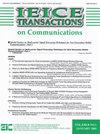基于2至66 GHz频段测量的ITU-R站点-一般路径损耗模型在城市地区的扩展
IF 0.6
4区 计算机科学
Q4 ENGINEERING, ELECTRICAL & ELECTRONIC
引用次数: 1
摘要
6ghz以上高频段的路径损耗是IMT-2020最基本、最重要的传播特性。为了开发和评估这种高频段,ITU-R SG5 WP5D最近发布了适用于高达100 GHz的信道模型。信道模型包括适用于0.5 ~ 100ghz的路径损耗模型。路径损耗模型用于小区设计和无线电技术评估,这是WP5D的主要目的。不同位置、Tx位置、频带和其他参数的预测精度在小区设计中非常重要。本文介绍了ITU-R M.2412报告中关于IMT-2020的UMa路径损耗模型的预测精度。我们还提出了UMa A’作为UMa A的扩展模型,UMa A对6ghz以下和6ghz以上的频段使用不同的方程来预测路径损耗,UMa A’使用6ghz以下的UMa A方程来预测所有频段。通过使用UMa A '模型,我们可以在宽频率范围(0.5-100 GHz)内考虑各种参数(如BS天线高度)来预测路径损耗。这对于考虑在宽频带的不同位置部署BS天线是有用的。我们通过在2至66 GHz频段,距离达1600米以及具有三个Tx天线高度的UMa环境中进行广泛测量来验证模型的准确性。在2 ~ 26.4 GHz频段,UMa A扩展模型预测路径损耗的RMSE较低,约为7 dB,比UMa A和UMa B模型的预测精度更高。虽然UMa A’模型在66 GHz的适用性尚不清楚,需要进一步验证,但66 GHz的评估结果表明,天线高度可能会影响66 GHz的预测精度。关键词:5G,传播,路径损耗模型,UMa, IMT-2020, rep ITUR M.2412本文章由计算机程序翻译,如有差异,请以英文原文为准。
Extension of ITU-R Site-General Path Loss Model in Urban Areas Based on Measurements from 2 to 66 GHz Bands
Path loss in high frequency bands above 6 GHz is the most fundamental and significant propagation characteristic of IMT-2020. To develop and evaluate such high frequency bands, ITU-R SG5 WP5D recently released channel models applicable up to 100 GHz. The channel models include path loss models applicable to 0.5–100 GHz. A path loss model is used for cell design and the evaluation of the radio technologies, which is the main purpose of WP5D. Prediction accuracy in various locations, Tx positions, frequency bands, and other parameters are significant in cell design. This article presents the prediction accuracy of UMa path loss models which are detailed in Report ITU-R M.2412 for IMT-2020. We also propose UMa A’ as an extension model of UMa A. While UMa A applies different equations to the bands below and above 6 GHz to predict path loss, UMa A’ covers all bands by using the equations of UMa A below 6 GHz. By using the UMa A’ model, we can predict path loss by taking various parameters (such as BS antenna height) into account over a wide frequency range (0.5–100 GHz). This is useful for considering the deployment of BS antennas at various positions with a wide frequency band. We verify model accuracy by extensive measurements in the frequency bands from 2 to 66 GHz, distances up to 1600 m, and an UMa environment with three Tx antenna heights. The UMa A’ extension model can predict path loss with the low RMSE of about 7 dB at 2–26.4 GHz, which is more accurate than the UMa A and UMa B models. Although the applicability of the UMa A’ model at 66 GHz is unclear and needs further verification, the evaluation results for 66 GHz demonstrate that the antenna height may affect the prediction accuracy at 66 GHz. key words: 5G, propagation, path loss model, UMa, IMT-2020, Rep. ITUR M.2412
求助全文
通过发布文献求助,成功后即可免费获取论文全文。
去求助
来源期刊

IEICE Transactions on Communications
工程技术-电信学
CiteScore
1.40
自引率
28.60%
发文量
101
审稿时长
3.7 months
期刊介绍:
The IEICE Transactions on Communications is an all-electronic journal published occasionally by the Institute of Electronics, Information and Communication Engineers (IEICE) and edited by the Communications Society in IEICE. The IEICE Transactions on Communications publishes original, peer-reviewed papers that embrace the entire field of communications, including:
- Fundamental Theories for Communications
- Energy in Electronics Communications
- Transmission Systems and Transmission Equipment for Communications
- Optical Fiber for Communications
- Fiber-Optic Transmission for Communications
- Network System
- Network
- Internet
- Network Management/Operation
- Antennas and Propagation
- Electromagnetic Compatibility (EMC)
- Wireless Communication Technologies
- Terrestrial Wireless Communication/Broadcasting Technologies
- Satellite Communications
- Sensing
- Navigation, Guidance and Control Systems
- Space Utilization Systems for Communications
- Multimedia Systems for Communication
 求助内容:
求助内容: 应助结果提醒方式:
应助结果提醒方式:


